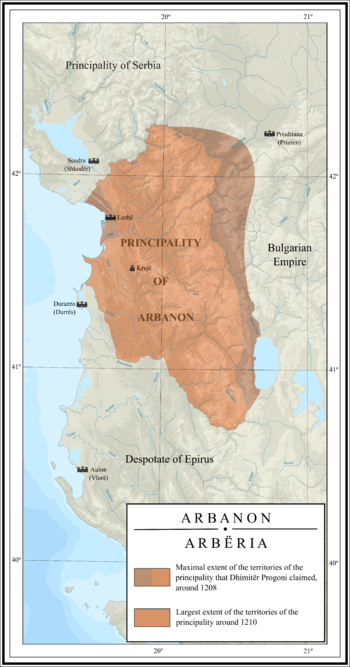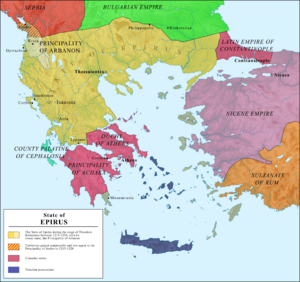Principality of Arbanon facts for kids
Quick facts for kids
Principality of Arbanon
Principata e Arbërit (Albanian)
|
|||||||||
|---|---|---|---|---|---|---|---|---|---|
| 1190–1215/16 (annexed ca. 1256/57) | |||||||||

Arbanon/Arbëria, ca. 1208
|
|||||||||
| Status | Principality | ||||||||
| Capital | Krujë | ||||||||
| Common languages | Albanian | ||||||||
| Religion | Roman Catholicism Eastern Orthodoxy |
||||||||
| Government | Principality | ||||||||
| Prince | |||||||||
|
• 1190–1198
|
Progon (first) | ||||||||
|
• 1198–1208
|
Gjin | ||||||||
|
• 1208–1216
|
Demetrius | ||||||||
| Historical era | Medieval | ||||||||
|
• Established
|
1190 | ||||||||
|
• Disestablished
|
1215/16 (annexed ca. 1256/57) | ||||||||
|
|||||||||
| Today part of | Albania | ||||||||
Arbanon (Albanian: Arbër or Arbëria; Latin: Arbanum) was an important early Albanian state. It was a principality (a state ruled by a prince) that began in 1190. The Progoni family were its first rulers.
Arbanon was located around the city of Krujë in what is now Albania. It was the first recorded Albanian state in history. The first ruler was Progon, who was a local leader. His sons, Gjin and then Demetrius, ruled after him. They kept Arbanon quite independent from the powerful Byzantine Empire.
In 1204, Arbanon became fully independent for a short time. This happened because the Byzantine Empire was weakened after its capital, Constantinople, was attacked during the Fourth Crusade. However, this independence didn't last long. Around 1216, the ruler of Epirus, Michael I Komnenos Doukas, took over Kruja. This ended the Progoni family's rule.
After Demetrius died, Arbanon was controlled by different powers. First, it was ruled by the Despotate of Epirus. Then, the Bulgarian Empire took control. From 1235, it was part of the Empire of Nicaea. During this time, local lords like Gregory Kamonas and Golem ruled parts of Arbanon. Finally, in 1256–57, the Byzantine Empire officially took over Arbanon. Most of what we know about Arbanon comes from the writings of a Byzantine historian named George Akropolites.
Contents
What's in a Name?
The name of the principality was Árvanon in Greek and Arbanum in Latin. In an old Serbian document from the 1200s, it was called Raban.
This name comes from an ancient Illyrian tribe called the Albanoi. This name was used for the Albanian people until the 1700s, when "Shqiptar" became more common.
Even older versions of the name, like "Arbën," have been found. In the 2nd century BC, a historian named Polybius wrote about a place called Arbona. Some Illyrian soldiers fled there to escape the Romans. In the 6th century AD, another writer, Stephanus of Byzantium, mentioned a city in Illyria called Arbon. He called its people Arbonios or Arbonites.
Arbanon's Status
Many historians agree that the Principality of Arbanon was the first Albanian state to appear in the Middle Ages. It was mostly independent until Demetrius died in 1216. After that, it became a vassal state (meaning it was controlled by a more powerful state) of either Epirus or the Empire of Nicaea.
From 1190 to 1204, Arbanon was a part of the Byzantine Empire. However, it had a lot of freedom. The titles used by its rulers, like 'archon' for Progon and 'panhypersebastos' for Demetrius, show they were still connected to the Byzantines. After Constantinople was attacked in 1204, the Byzantine Empire became weaker. Arbanon then gained full independence for about 12 years, until Demetrius died.
An old stone carving, called the Gëziq inscription, mentions the Progoni family as judices (judges). It also shows they had some connection to the princes of Zeta (a Serbian state). In its later years, Arbanon was mainly linked to the Despotate of Epirus. It also had friendly ties with the Kingdom of Serbia. In 1252, the ruler Golem agreed to be under the Empire of Nicaea.
Where Was Arbanon?
In the 11th century, the name Arbanon was used for a mountainous area. This area was west of Ohrid Lake and near the upper part of the Shkumbin river valley.
In 1198, a small part of the area north of the Drin river was briefly controlled by Stefan Nemanjić of Serbia. He said he captured Pult from Arbanon that year.
In 1208, Demetrius Progoni wrote to Pope Innocent III. He claimed to be the "prince of the Albanians" over an area between Shkodra, Prizren, Ohrid, and Durrës. Demetrius helped the principality reach its largest size. At this time, Arbanon stretched from the Shkumbin river valley in the south to the Drin river valley in the north. It went from the Adriatic Sea in the west to the Black Drin river in the east.
The historian George Akropolites described Arbanon's territory in its final years. He said it was between Durrës and Lake Ohrid (west to east). It was also between the Shkumbin river valley and the Mat river valley (south to north). The Krujë fortress was the main military and administrative center of Arbanon throughout its existence.
A Look at History
How Arbanon Started
We don't have many sources about Arbanon. The most detailed information comes from the writings of the Byzantine historian George Akropolites.
We know that in 1166, a leader named Andrea and a bishop named Lazarus from Arbanon attended a ceremony in Kotor. A year later, in 1167, Pope Alexander III wrote to Bishop Lazarus. He congratulated him for bringing his bishopric back to the Catholic faith. The Pope wanted Lazarus to report to the archbishop of Ragusa. After some local disagreement, the bishopric of Arbanon was placed directly under the Pope in 1188.
Not much is known about archon Progon. He was the first ruler of Kruja and its surrounding areas between 1190 and 1198. The Progoni family kept control of the Kruja fortress. Progon was followed by his son Gjin, who died around 1207 or 1208. Then, his other son Demetrius took over.
Demetrius Progoni's Rule
Demetrius was the third and last ruler from the Progoni family. He ruled from about 1207/1208 to 1215/1216. He made the principality as strong as it could be.
From the start, Demetrius tried to make friends with other countries. He wanted to keep Arbanon safe from outside threats. The main threats were the Republic of Venice and later the Despotate of Epirus.
Around 1208-1209, Demetrius thought about changing from Eastern Orthodoxy to Catholicism. He hoped this would get him support against Venice. Venice had claimed control over Albania. If Arbanon became Catholic, Venice's claims might be weaker, as Arbanon would be another Catholic state. This would also protect him from new states that formed after the Byzantine Empire weakened, like the Despotate of Epirus.
In letters to Pope Innocent III, Demetrius asked the Pope to send missionaries to spread Catholicism in his land. The Pope agreed and told a Catholic leader in Durrës to prepare for the mission. However, Demetrius soon stopped this process. He had defeated a Venetian ally, so he felt less threatened by Venice.
In 1208, Demetrius also arranged a marriage with Komnena Nemanjić. She was the daughter of a Serbian ruler and the granddaughter of the last Byzantine Emperor. Because of his wife's connection to the Byzantine royal family, Demetrius was given the special title of panhypersebastos.
Later, after the Catholic archbishop of Durrës died, both Venice and Demetrius took church property in their areas. Because of this, Demetrius was excommunicated (kicked out of the church). He called himself princeps Arbanorum ("prince of the Albanians"). Other foreign leaders recognized him by this title.
In his letters to Pope Innocent III, Demetrius said his territory was between Shkodra, Prizren, Ohrid, and Durrës. As mentioned before, he expanded the principality from the Shkumbin river valley to the Drin river valley. It also stretched from the Adriatic Sea to the Black Drin river. In Latin documents, Demetrius was also called iudex (judge). In Byzantine records, he was called megas archon (great ruler) and later panhypersebastos.
In 1209, Demetrius made a treaty with the Republic of Ragusa (modern-day Dubrovnik). This allowed Ragusa's merchants to travel freely through Arbanon. The next year, Venice and Michael I Komnenos Doukas of the Despotate of Epiros made an agreement. Doukas would become a vassal of Venice if Venice recognized his claims up to the Shkumbin river valley, which was a main part of Arbanon. In 1212, Venice also let Michael take control of the coastal area of Durrës. This agreement was bad for Arbanon. By the end of Demetrius's life, the principality seemed to be much smaller, only between the Shkumbin and Drin rivers.
An inscription from a Catholic church in Gëziq (near modern Rreshen) gives us information about this time. The inscription, written in Latin after Demetrius's death, shows that he had given money to build the church. He might have wanted it to be the main church for the region. He had kept his area semi-independent by agreeing to be under the rule of Zeta, but Zeta didn't interfere in Arbanon's internal matters. The inscription also says that Demetrius dedicated the church to his people and named his nephew, Progon (son of Gjin), as his successor.
Gregory Kamonas and Golem's Rule
When Demetrius died in 1215 or 1216, his wife Komnena took power. She soon married Gregory Kamonas. He had been married to Gjin's daughter before. This marriage helped him gain control of Kruja. He also made stronger ties with the Grand Principality of Serbia.
Demetrius had no son to take over. Komnena had a daughter with Kamonas. This daughter married a local noble named Golem. Golem continued to rule Arbanon as a semi-independent leader. He was under Theodore Komnenos Doukas of the Despotate of Epiros until 1230. Then he was under Ivan Asen II of Bulgaria until 1241. After that, he switched between supporting Epirus and the Empire of Nicaea.
Finally, the Empire of Nicaea took over Arbanon between 1252 and 1256. Golem and another leader, Theodore Petraliphas, had first been allies of Epirus. But in 1252, they switched to support Nicaea. However, Nicaea's control was short-lived. The Emperor Theodore II Laskaris appointed Constantine Chabaron to rule Arbanon. This led to the Rebellion of Arbanon in 1257.
Golem is last mentioned in historical records in a meeting with George Akropolites in Durrës in the winter of 1256–1257. Akropolites then officially took over Arbanon. He set up a Byzantine government, military, and tax system there.
Economy
Arbanon benefited from the Via Egnatia, an important ancient trade road. This road brought wealth and goods from the more developed Byzantine areas.
Rulers of Arbanon
- Progon (around 1190–1198)
- Gjin Progoni (1198–1208)
- Demetrius Progoni (around 1208 – around 1216)
- Gregory Kamonas (around 1216 – ?)
- Golem (around 1252 – around 1256)
- Constantine Chabaron (around 1256 – around 1257)
Images for kids
See also
 In Spanish: Principado de Arbanon para niños
In Spanish: Principado de Arbanon para niños
- Rebellion of Arbanon
- Albanian principalities
- History of Albania







